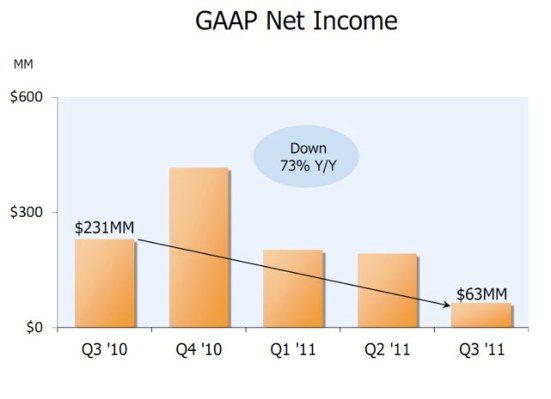Amazon’s third quarter profits are down a stunning 73 percent. The stock is getting slammed in after-hours trading (down $28 right now). And yet revenues were up 44 percent to $10.9 billion and on the conference call today Amazon CFO Tom Szkutak says, “We expect to have a record quarter in terms of device sales in Q4.”
As well it should. Amazon announced a new line of Kindles in September, including a tablet, the Kindle Fire. Orders for the new Kindles are double what they were the last time Amazon launched a new line, and it is “building millions more” Kindle Fires than it had anticipated, according to CEO Jeff Bezos. So where did all the money go?
Amazon is ramping up investments in the backend infrastructure to support all the digital media it expects people will want to consume on their Kindles, especially their Kindle Fires. It is spending a lot of money on both technology and content. Amazon spent $769 million on “technology and content” in the quarter, up 74 percent from a year ago. And it invested nearly $1.6 billion on “fixed assets, including internal use software and website development,” which is double the amount it spent a year ago, according to one of its investor slides.
In other words, it is investing for the future, and intends to keep on doing so. “In terms of content, we will be purchasing content for both our U.S. business, for both our paid and unpaid (Prime) business in Q4,” says Szkutak. Amazon will need to pay out a lot more in streaming licensing fees to the Hollywood studios if it wants to catch up to Netflix and Hulu. And with the Kindle Fire, it expects to have a built-in audience of millions of people for streaming movies. It needs to license that content before those consumers can watch it.
The Kindle will put other pressures on Amazon’s back-end Web Services as well. It’s custom Silk browser, for instance, will offload much of the work of delivering web pages quickly to the Kindle Fire to the cloud where it will pre-cache a lot of the elements of each page. Over time that will put more strain on Amazon Web Services to deliver a seamless consumer experience.
Amazon is also investing in overall capacity, including beefing up its fulfillment centers so that it can deliver those Kindles without too many hiccups. But for the most part, it is spending in advance of its rollout of new Kindles and the digital media they are designed to envelop.
